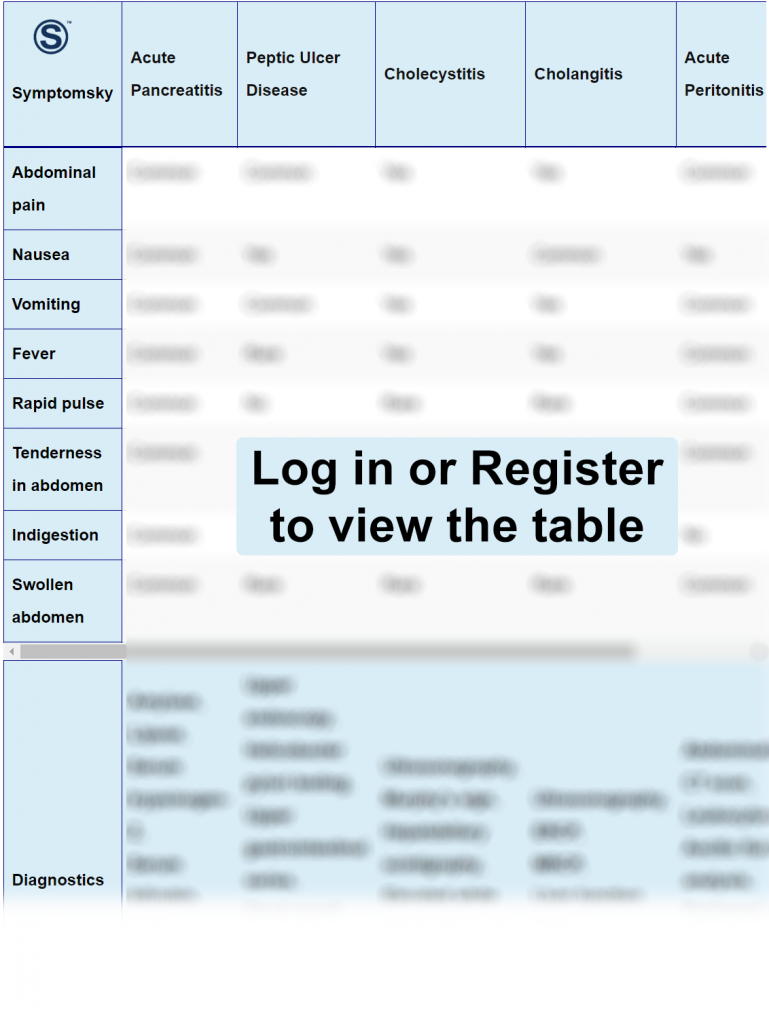Contents
- 1 Acute Pancreatitis Differential Diagnosis Table:
- 2 How to Distinguish Acute Pancreatitis from Other Conditions
- 2.1 Distinguish Peptic Ulcer Disease from Acute Pancreatitis – Diagnosis
- 2.2 Distinguish Cholecystitis from Acute Pancreatitis – Diagnosis
- 2.3 Distinguish Cholangitis from Acute Pancreatitis – Diagnosis
- 2.4 Distinguish Acute Peritonitis from Acute Pancreatitis – Diagnosis
- 2.5 Distinguish Bowel Obstruction from Acute Pancreatitis – Diagnosis
- 3 Important Red Flags with Acute Pancreatitis
Acute Pancreatitis Differential Diagnosis Table:

This is the acute inflammation of the pancreas and the adjacent tissues usually triggered by gallstones and alcohol intake. Some inherited characteristics have also been found to be causing acute pancreatitis in 80% of patients with the mutation of the cationic trypsinogen. Acute pancreatitis is usually classified into mild, moderately severe, and severe based on the presence of local complications and persistent organ failure.
Another classification places acute pancreatitis into two namely; interstitial and necrotizing pancreatitis. Symptoms include upper abdominal pain radiating through the back in 50% of the patients, nausea, vomiting, elevated pulse rate, shallow and rapid respiration, abdominal tenderness, and distention.
Diagnosis involves serum markers and different imaging studies but is established by the presence of two of the following: abdominal pain consistent with the disease or serum amylase and/or lipase >3 times the upper limit of normal or characteristic findings on contrast-enhanced cross-sectional imaging studies. Treatment measures are supportive but for severe cases, antibiotics and necrosectomy may be done.
How to Distinguish Acute Pancreatitis from Other Conditions
Distinguish Peptic Ulcer Disease from Acute Pancreatitis – Diagnosis
This is an erosion of part of the gastrointestinal mucosa, more specifically in the stomach or the first few centimeters of the duodenum that penetrates through the muscularis mucosae.
- Acute pancreatitis is triggered by gallstones and alcohol intake while peptic ulcer disease is caused by Helicobacter pylori infection.
- Endoscopy is a key diagnosis in PUD while a CT scan is commonly used to visualize acute pancreatitis.
Distinguish Cholecystitis from Acute Pancreatitis – Diagnosis
Cholecystitis is basically inflammation of the bladder usually caused by obstruction of the cystic duct leading to distention of the gallbladder.
- In cholecystitis, the pain is usually located in the right upper quadrant below the ribcage while in acute pancreatitis the pain is primarily located in the upper abdomen and it often radiates to the back.
- Diagnostic markers for cholecystitis are usually elevated white blood cell count and bilirubin levels while those for acute pancreatitis include elevated amylase and lipase levels in the blood.
Distinguish Cholangitis from Acute Pancreatitis – Diagnosis
Cholangitis involves inflammation of the biliary system, more specifically the bile duct usually caused by gallstones and bacterial infection.
- Cholangitis pain is mainly concentrated in the right upper quadrant while acute pancreatitis pain is concentrated in the upper abdomen radiating to the back.
- Jaundice is a prominent symptom in cholangitis while it doesn’t often occur in acute pancreatitis.
- Diagnostic markers for cholangitis include elevated liver enzymes while those for acute pancreatitis include elevated lipase and amylase.
Distinguish Acute Peritonitis from Acute Pancreatitis – Diagnosis
This involves inflammation of the inner lining of the abdomen (peritoneal cavity) usually caused by gastrointestinal rupture and perforation.
- In acute peritonitis, tenderness is throughout the abdomen while acute peritonitis specifically presents with epigastric tenderness.
- Diagnostic markers for acute peritonitis include elevated white blood cell count while those for acute pancreatitis include elevated lipase and amylase.
Distinguish Bowel Obstruction from Acute Pancreatitis – Diagnosis
This is a partial or complete blockage of the small and large intestines preventing fluid and food from passing through.
Important Red Flags with Acute Pancreatitis
Acute pancreatitis presents with a variety of symptoms that pose a threat to the body. Some of the red flags include severe abdominal pain, nausea and vomiting, elevated amylase and lipase levels, abdominal tenderness, and respiratory distress in severe cases.
Proper diagnostic measures including physical and clinical examination, imaging tests, and blood tests can be used to differentiate it from other conditions.
